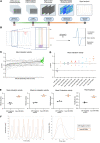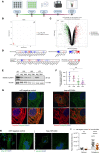hsa-miR-548v controls the viscoelastic properties of human cardiomyocytes and improves their relaxation rates
- PMID: 38165745
- PMCID: PMC11143964
- DOI: 10.1172/jci.insight.161356
hsa-miR-548v controls the viscoelastic properties of human cardiomyocytes and improves their relaxation rates
Abstract
The impairment of left ventricular (LV) diastolic function with an inadequate increase in myocardial relaxation velocity directly results in lower LV compliance, increased LV filling pressures, and heart failure symptoms. The development of agents facilitating the relaxation of human cardiomyocytes requires a better understanding of the underlying regulatory mechanisms. We performed a high-content microscopy-based screening in human induced pluripotent stem cell-derived cardiomyocytes (hiPSC-CMs) using a library of 2,565 human miRNA mimics and measured relaxation kinetics via high-computing analyses of motion movies. We identified hsa-miR-548v, a primate-specific miRNA, as the miRNA producing the largest increase in relaxation velocities. This positive lusitropic effect was reproduced in engineered cardiac tissues generated with healthy and BRAF T599R mutant hiPSC-CMs and was independent of changes in calcium transients. Consistent with improvements in viscoelastic responses to mechanical stretch, RNA-Seq showed that hsa-miR-548v downregulated multiple targets, especially components of the mechanosensing machinery. The exogenous administration of hsa-miR-548v in hiPSC-CMs notably resulted in a significant reduction of ANKRD1/CARP1 expression and localization at the sarcomeric I-band. This study suggests that the sarcomere I-band is a critical control center regulating the ability of cardiomyocytes to relax and is a target for improving relaxation and diastolic dysfunction.
Keywords: Cardiology; Heart failure; Stem cells; iPS cells.
Conflict of interest statement
Figures






Similar articles
-
Integration of co-culture conditions and 3D gelatin methacryloyl hydrogels to improve human-induced pluripotent stem cells-derived cardiomyocytes maturation.Front Bioeng Biotechnol. 2025 Jul 14;13:1576824. doi: 10.3389/fbioe.2025.1576824. eCollection 2025. Front Bioeng Biotechnol. 2025. PMID: 40727646 Free PMC article.
-
Chronic Activation of Tubulin Tyrosination Improves Heart Function.Circ Res. 2024 Oct 11;135(9):910-932. doi: 10.1161/CIRCRESAHA.124.324387. Epub 2024 Sep 16. Circ Res. 2024. PMID: 39279670 Free PMC article.
-
Healthy human induced pluripotent stem cell-derived cardiomyocytes exhibit sex dimorphism even without the addition of hormones.Stem Cells. 2025 Aug 22;43(9):sxaf038. doi: 10.1093/stmcls/sxaf038. Stem Cells. 2025. PMID: 40578843 Free PMC article.
-
MicroRNAs in oral fluids (saliva and gingival crevicular fluid) as biomarkers in orthodontics: systematic review and integrated bioinformatic analysis.Prog Orthod. 2021 Oct 11;22(1):31. doi: 10.1186/s40510-021-00377-1. Prog Orthod. 2021. PMID: 34632546 Free PMC article.
-
Human iPSC-Cardiomyocytes as an Experimental Model to Study Epigenetic Modifiers of Electrophysiology.Cells. 2022 Jan 7;11(2):200. doi: 10.3390/cells11020200. Cells. 2022. PMID: 35053315 Free PMC article. Review.
Cited by
-
Rod-shaped micropatterning enhances the electrophysiological maturation of cardiomyocytes derived from human induced pluripotent stem cells.Stem Cell Reports. 2024 Oct 8;19(10):1417-1431. doi: 10.1016/j.stemcr.2024.08.005. Epub 2024 Sep 19. Stem Cell Reports. 2024. PMID: 39303707 Free PMC article.
References
-
- Phan TT, et al. Heart failure with preserved ejection fraction is characterized by dynamic impairment of active relaxation and contraction of the left ventricle on exercise and associated with myocardial energy deficiency. J Am Coll Cardiol. 2009;54(5):402–409. doi: 10.1016/j.jacc.2009.05.012. - DOI - PubMed
Publication types
MeSH terms
Substances
LinkOut - more resources
Full Text Sources
Medical
Molecular Biology Databases
Research Materials

